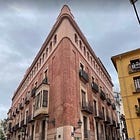Living The Semi-Retired Life: More Of The Best Of 2023
Part two
So, I’m saying I’m going to take off the week between Christmas and New Year’s Day. But this doesn’t mean I will take off the week between Christmas and New Year’s Day. In case you don’t hear from me, it actually happened. But, don’t be surprised if you do hear from me.
Want a little less ambiguity?
You can find it in our newsletter plans for 2024 and 2025 detailed here—
I have never been more excited about my writing or life plans. These next two years will be chock full of content chronicling and detailing every little aspect of semi-retired personal finance and the entire process of moving to Spain, not to mention this February’s trip to Spain and France.
In February, expect—
7 posts from each of the seven cities we’re visiting (Barcelona, Girona, Montpelier, Lyon, Paris, Bordeaux and Toulouse) with urban and food photography, cost of living comparisons and general observations as they relate to Living The Semi-Retired Life.
10 excruciatingly detailed posts on investing, saving and work-related semi-retirement income streams. Because most of us need multiples.
I plan to take actual grocery shopping trips in the US and do hypothetical trips to buy equivalent items in Spain and France to highlight differences in cost of living.
So—it’s an ideal time to upgrade to a paid subscription or, if you’re already a paid subscriber, a founding membership.
Now, let’s finish off 2023 with what we started yesterday.
Speaking of every little aspect of semi-retired personal finance, let’s do it by focusing on what might be the two most important elements—housing and budgeting (even if you don’t actually keep a budget).
But first … who approved a Samsung ad on this incredible structure in Barcelona?
The best way to kick things off is with a blurb I included in a newsletter post from 2023.
It sums up my approach to writing this newsletter and organizing big life decisions that include many moving parts.
I have never been a believer in believing in something simply for the sake of believing in something. Or wanting something simply because everybody else seems to have or want it. People who are like this annoy the living hell out of me.
If I’m going to do something—particularly something big—there has to be a basis, even a methodology behind it. Sounds rigid, except it’s not. Good organization leaves space for the best kind of messiness, even good chaos.
I’m convinced that—without organization—you can’t do spontaneity well. And you’ll have a more difficult time optimizing big life decisions, such as moving, particularly if the move involves components such as obtaining a visa, changing your cost of living and securing new housing.
We touched on this yesterday when we discussed how to organize work.
If you just—
sit down to work without a plan
without some timing and structure
and some logic BEHIND your timing and structure
you’re just working
you’re not working less now so you can work less longer as something more than a cute slogan.
I don’t want to work all day and collapse at night. We’ll have periods where we do this. But, the ultimate goal is semi-retirement where you fit work in between your breaks at living life, not the other typical way around.
This is extra important for me, particularly when we move to Spain. Because, as much as we’re moving there to live that lifestyle day to day, on the ground, there’s no denying we’ll have a hunger to do everything all at once, especially at the beginning. So, I’ll require structure that provides natural breaks in life for work.
Along similar lines, lots of people say they want to move to another country. But they have literally zero idea how to do it. Ask them which visa they’ll use, how they’ll qualify, how they’ll make money abroad, how the tax and other bureaucratic systems function and they look at you with a blank stare. You see it in real life. You see it in the Facebook Groups.
This is why so much of what is in this newsletter includes numbers. But they’re not numbers from a bean counter who doesn’t dream … and dream big.
The key—there’s a difference between being a dreamer and having no plan and being a dreamer with not only a plan, but a foundational comprehension of what you’re getting into logistically/culturally/whatever and how to navigate these systems. Not to mention a close-to-certain understanding of these systems and if you’ll like living as part of them.
You want to move to Spain—exactly how will you get there?
You want to bitch about taxes—how about you actually understand them?
You want to rent an apartment when you arrive—how you will make it easiest on yourself financially?
You want to buy an apartment after a few years—what’s that going to look like?
You want to buy a second home after the apartment—how’s that going to fly?
Which leads us to a summary of some of my other favorite 2023 newsletter installments.
Here’s a hypothetical money situation and how it might evolve into full-blown semi-retirement.
You’re at or around middle age. The curtain on the second act of your life has stagehands peeking out from behind it.
You take home roughly $5,000 a month.
You pay $1,850 in rent, $400 for transportation, $400 for healthcare and $1,000 in utilities, groceries and other bills, leaving roughly $1,350 leftover each month.
You have $50,000 saved. Zero investments. You don’t have a clear saving plan. Most of that $1,350 seems to disappear into the ether most months.
I’m confident many, if not most elements of this broad situation apply to more than a few people. Of course, you might be in a two-earner household, have kids, own a home, have no mortgage or most certainly have some other specific factor that makes your numbers different from these numbers. However, it’s not the exact numbers that matter as much as using them to illustrate exactly how you can get to full-blown semi-retirement with very little money in the bank.
… you don’t see a future paying $2,250-a-month for your two largest expenses. And you’d like to work less so you don’t have to earn $5,000 a month.
Let’s just step-by-step how it can look—adding a bullet point or two for alternatives to the main bullet point. I’d love it if you provide some color on your situation and future plans to deal with it—if you even have to—in the comments.
You commence a three-year plan.
In the first six months, the goal is to save $500 a month and put $500 a month towards that transportation expense to eliminate your car payment, ending up with a $200 transportation expense and $53,000 in savings.
For the next six months, you save $800 a month, bringing your savings to $57,800.
During year one (preferably earlier), you’re researching less expensive places to move where you can—initially—rent for less and eventually buy for relatively cheap.
For my partner and I, it’s Valencia, Spain. In Spain, we can eliminate our transportation expense, lower our rent from $1,400 a month to around, if not less than $1,000 and—if all goes as hoped and intended—have a housing payment that ranges from ZERO to less than $1,000 (aside from taxes, insurance, upkeep) after we buy an apartment.
But this doesn’t have to happen abroad. We’ll do a list soon—real soon—of American cities where you can go on this rent-to-buy trajectory for around—though maybe a little more than—what we think it will cost us in Spain. Again, we’re doing an illustration here today.
You start year two in this place. We’ll keep the transportation cost at $200, though, ideally, you eliminate it. Rent goes from $1,850 to $1,200. This frees up another $650, bringing your total monthly free cash flow to $2,200 a month. If you can eat away a little at that $1,000 you pay each month for utilities, groceries and other, great.
From that $2,200 a month, you commit to saving $1,750 a month, bringing your savings at the end of year three to $99,800. Call it $100,000.
Now, you have a choice to make.
Stay the course and save more? At the end of two more years, you’ll have at least $142,000 saved.
Or take the plunge right there and then at the end of year two and buy a house.
We explored this choice—in great quantitative detail—in a subsequent installment—
Which led to one of the best—and most controversial—discussions we have had around housing since the housing survey we did earlier in 2023.
Housing posts were the ones with the most engagement throughout the year. Probably because housing is a huge issue in America and throughout the world. It can make or break your situation.
These posts showed that not all subscribers to this newsletter have relatively life-changing housing choices to make. More than a few report being all set on housing.
Because it’s not only popular, but important, we’ll do a lot more on housing in 2024.
But first, some of my other favorite posts of 2023 to end the year—a few from me and a few from some of my friends—
And from a few of my friends and favorites!!
But first, in closing, happy holidays and the absolute best to you for 2024 and beyond.
I struggle to express how much writing this newsletter means to me for fear of being cheesy. But I’ll say, it’s one of those things where when I say it doesn’t feel like work, it’s actually true.
It’s not always easy. I regularly overcome obstacles with flow, structure and organization of ideas similar to the ones I face in other writing. But, with the newsletter, the payoff is always there.
With most everything else, you write it because, yeah, you enjoy it, but ultimately it’s to get paid. Because this is my job. To that end, no doubt, I like and expect to get paid for doing this, but I never have the feeling of—good, now I’m done with that so I can get paid. I’m always thinking and excited about what comes next. Probably because this is my life. So, expect this newsletter to change and evolve as my journey does likewise.















Thank you for including my on your list! You've got me in some great company there.
As gen Xers, we're hardwired to recoil from anything cheesy, but you've articulated something really well; I like/expect to get paid for my labor, but writing on here rarely feels like anything resembling work.
Looks like the Barcelona cathedral has a side hustle as they hide the scaffold and workers behind the screen. We in the construction industry call that netting a gawk-block, but it is also for stopping any falling items like nails, wood, or plaster. Smart of the cathedral to allow someone to pay for advertising.
Your key differences and bullet points in this article are something I find people in FB expat groups fail to consider before they make their move. It is like the people getting gastric bypass surgery before learning how you will have to eat afterward. It is forced change without understanding, which makes for a bad experience. The more understanding of everything, and I do mean everything you can, will lead to an easier transition so you can enjoy the place or thing you decided to do to yourself. I realize you cannot learn everything-everything, but the more you do know, the less disappointment you will have when the things you were not prepared for, happen.